
Sarah Bauder
Sarah has been writing on the topics of politics, history and finance for over a decade. She is currently an editor at CPI Inflation Calculator, covering the topics of CPI, inflation, US economy and economic commentary.

by Sarah Bauder | Dec 10, 2020 | CPI, Definitions
The Consumer Price Index for All Urban Consumers (CPI-U) edged up 0.2% in November, reported the U.S. Bureau of Labor Statistics. Before seasonal adjustment, the all items index increased 1.2% since this time last year.
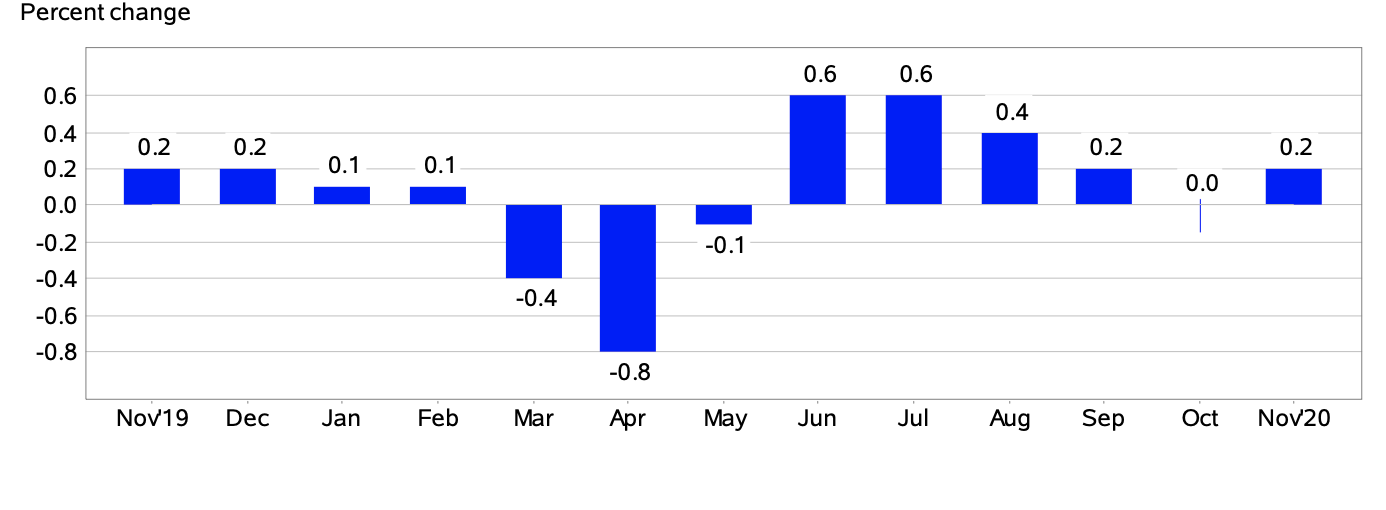
(Source: U.S. Bureau of Labor Statistics)
Food Index
The index for food dropped 0.1% in November, after rising 0.2% the previous month. The food at home index decreased 0.3%.
“Major grocery store food group indexes were mixed in November. The index for nonalcoholic beverages fell 0.9 percent in November, its largest monthly decline since December 2010. The index for other food at home fell 0.6 percent in November, and the index for cereals and bakery products decreased 0.5 percent; both indexes increased in October,” reported the U.S. Bureau of Labor Statistics.
Over the past 12 month period, the food at home index rose 3.6%. All six major grocery store group indexes saw percentage increases since this time last year. The index for meats, poultry, fish, and eggs saw the largest percentage rise at 5.9%, with specifically the index for beef edging up 7.5% over the last 12 months. Likewise, the food away from home index increased by 3.8% over the same timeframe.
Energy Index
The index for energy increased 0.4% in November, marking the sixth consecutive monthly percentage rise. The indexes for natural gas, electricity, and fuel oil all rose, 3.1%, 0.5%, 3.6%, respectively.
“In contrast to these increases, the gasoline index declined for the second month in a row, falling 0.4%. Before seasonal adjustment, gasoline prices fell 2.7% in November,” stated the bureau in its report.
Over the last 12-month period, the energy index dropped 9.4%. The price of gasoline plunged 19.4%, and the index for fuel oil plummeted an astonishing 26.4% since this time last year. Conversely, the natural gas and electricity indexes rose 4.4% and 1.6%, respectively.
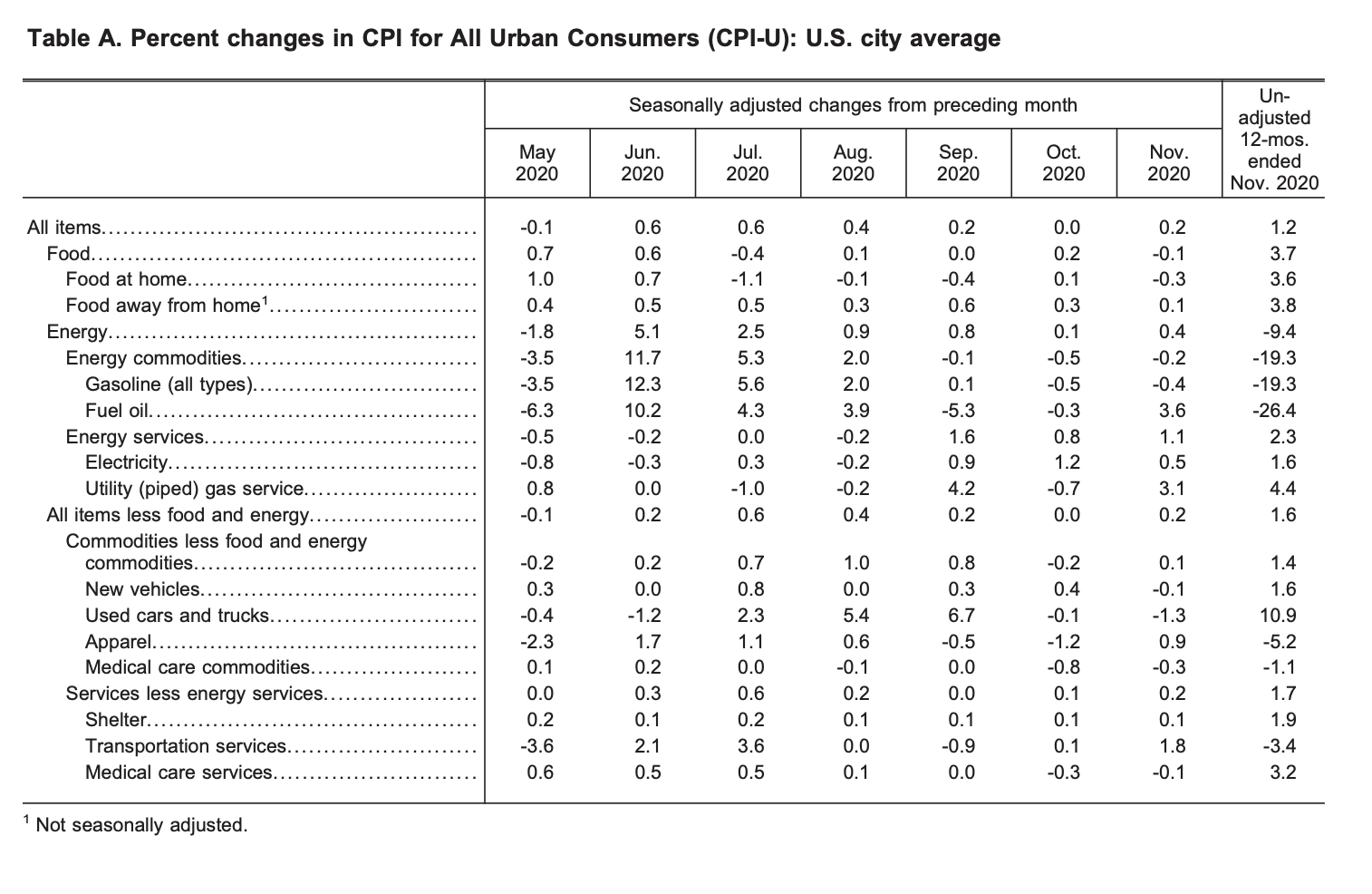
(Source: U.S. Bureau of Labor Statistics)
All Items Less Food and Energy
In November, the all items less food and energy index edged up 0.2%, reported the U.S. Bureau of Labor Statistics. Several component indexes saw percentage increases including the shelter index at 0.1%, the apparel index at 0.9%, airline fares at 3.5%, and motor vehicle insurance at 1.1%.
Over the last year, the all items less food and energy index increased by 1.6%. The index for shelter edged up 1.9% over the past 12-month span, as did the medical care index with a percentage increase of 2.4%.
“Despite the monthly increases in November, the indexes for apparel, airline fares, and motor vehicle insurance all declined over the past 12 months,” reported the U.S. Bureau of Labor Statistics.
The US Bureau of Labor Statistics released a statement on the impact of the COVID-19 pandemic for the November 2020 data collection:
“Data collection by personal visit for the Consumer Price Index (CPI) program has been suspended since March 16, 2020. When possible, data normally collected by personal visit were collected either online or by phone. Additionally, data collection in November was affected by the temporary closing or limited operations of certain types of establishments. These factors resulted in an increase in the number of prices considered temporarily unavailable and imputed. While the CPI program attempted to collect as much data as possible, many indexes are based on smaller amounts of collected prices than usual, and a small number of indexes that are normally published were not published this month. Additional information is available at www.bls.gov/covid19/effects-of-covid-19-pandemic-on-consumer-price-index.htm.”
Source cited: https://www.bls.gov/news.release/archives/cpi_12102020.htm
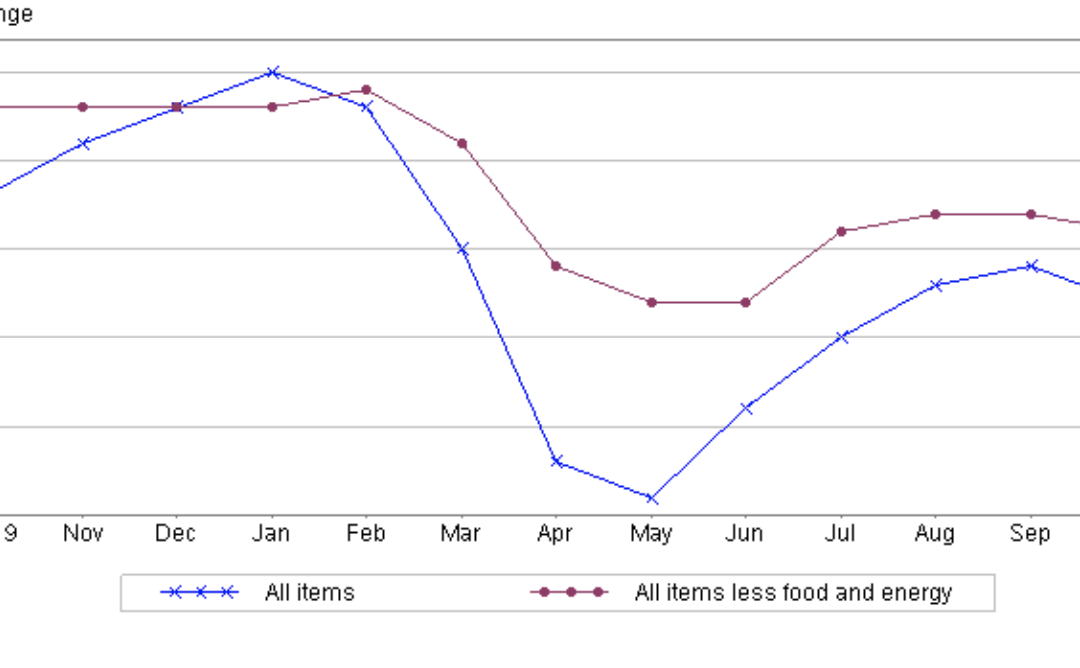
by Sarah Bauder | Nov 12, 2020 | CPI
The US Bureau of Labor Statistics reported that the Consumer Price Index for All Urban Consumers (CPI-U) in October remained the same on a seasonally adjusted basis. In September, the CPI had edged up 0.2%.
Before seasonal adjustment, the all items index increased by 1.2% over the past 12 month period.
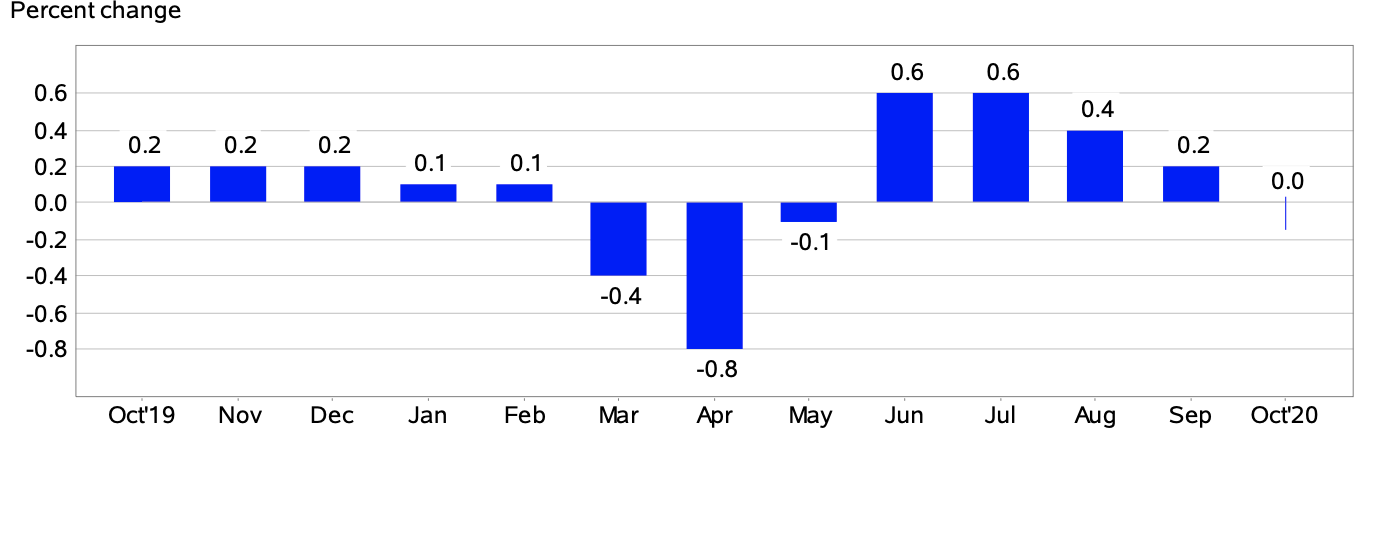
(Source: US Bureau of Labor Statistics)
Food Index
The index for food increased 0.2% after remained the same for the month of September. The food at home index rose 0.1%, with four of the six major grocery store group indexes seeing percentage increases.
“The index for meat, poultry, fish, and eggs increased 0.4 percent in October following a 0.4-percent decrease in September. The indexes for other food at home and for cereals and bakery products both rose 0.3 percent in October, while the index for fruits and vegetables increased 0.1 percent,” explained the bureau.
Over the past 12 month span, the index for food at home index increased 4%. All six major grocery store group indexes saw percentage increases since this time last year. Moreover, the food away from home index increased by 3.9% over the last 12 months – “the largest 12-month increase reported for that index since May 2009”, explained the US Bureau of Labor Statistics.
Energy Index
In October, the index for energy increased 0.1%, marking the fifth consecutive monthly percentage rise. “The electricity index was the largest contributor to this increase, increasing 1.2%,” stated the bureau. Gas prices dropped 0.5%, as did the natural gas index by 0.7%.
Over the last 12-months, the index for energy decreased 9.2%. The price of gasoline declined 18%, and the fuel oil index plummeted 28.2%. “In contrast, energy service indexes rose, with the index for natural gas increasing 1.8% and the index for electricity advancing 1.3%,” reported the bureau.

(Source: US Bureau of Labor Statistics)
All Items Less Food And Energy
In October, the all items less food and energy index remained the same, after rising 0.2% the previous month, stated US Bureau of Labor Statistics. Several of the component indexes all saw slight percentage increases for the month including the shelter index by 0.1%, and both the rent index and index for owners’ equivalent rent by 0.2%.
Over the last year, the all items less food and energy index increased by 1.6%. The index for shelter edged up 2%, as did the medical care index by 2.9%. Conversely, component indexes that saw percentage decreases were motor vehicle insurance, airline fares, and apparel stated the US Bureau of Labor Statistics.
The US Bureau of Labor Statistics released a statement on the impact of the COVID-19 pandemic on data collection:
“Data collection by personal visit for the Consumer Price Index (CPI) program has been suspended since March 16, 2020. When possible, data normally collected by personal visit were collected either online or by phone. Additionally, data collection in October was affected by the temporary closing or limited operations of certain types of establishments. These factors resulted in an increase in the number of prices considered temporarily unavailable and imputed. While the CPI program attempted to collect as much data as possible, many indexes are based on smaller amounts of collected prices than usual, and a small number of indexes that are normally published were not published this month. Additional information is available here.”
Source cited: https://www.bls.gov/news.release/archives/cpi_11122020.htm
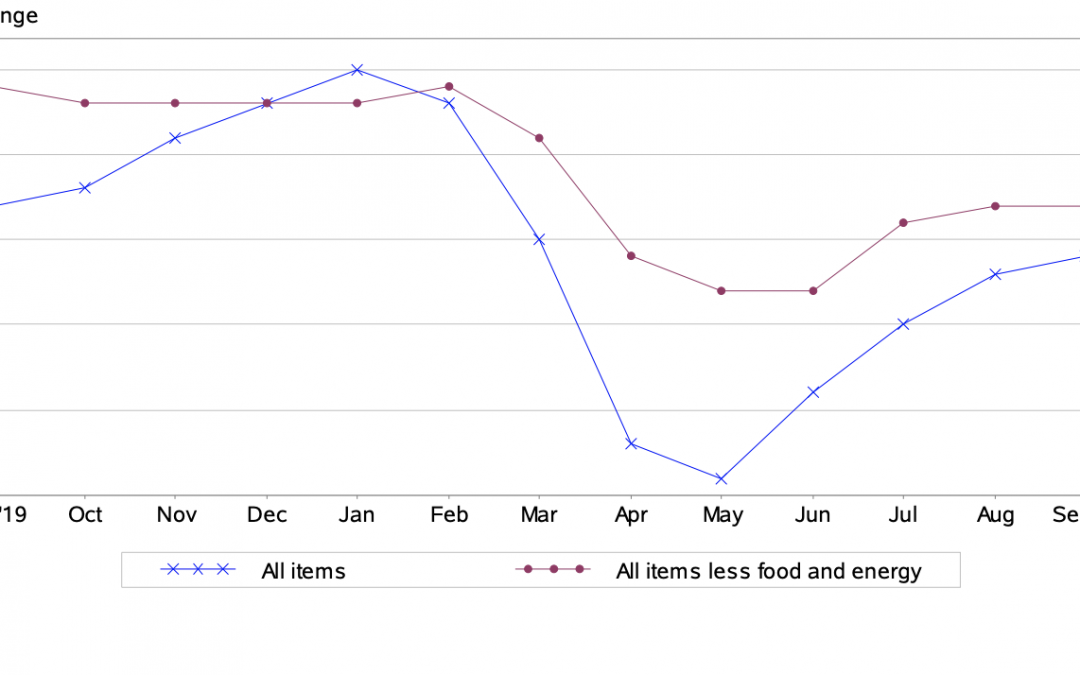
by Sarah Bauder | Oct 13, 2020 | CPI
The Consumer Price Index for All Urban Consumers (CPI-U) rose 0.2% on a seasonally adjusted basis, reported the US Bureau of Labor Statistics.
Before seasonal adjustment, the all items index increased by 1.3%, over the past 12 month period.

(Source: US Bureau of Labor Statistics)
Food Index
Surprisingly, the index for food remained the same for the month of September, reported the bureau. The food at home index dropped 0.4%, with five of the six major grocery store group indexes seeing percentage decreases. “The index for meats, poultry, fish, and eggs fell 0.4% in September, its third consecutive monthly decline,” explained the bureau. Conversely, the food away from home index rose 0.6%.
Over the past 12 month span, the index for food at home edged up 4.6%. All six major grocery store group indexes saw percentage increases since this time last year. Additionally, the food away from home index increased by 3.8% over the last 12 months.
Energy Index
In September, the index for energy increased by 0.8%, marking the fourth consecutive monthly percentage rise. “ However, unlike previous months, the index for natural gas was the largest contributor to the monthly increase, rising 4.2 percent, its largest monthly increase since December 2018,” reported the US Bureau of Labor Statistics. In addition, the index for electricity increased by 0.9%, which also marked its largest rise in two years.
Over the last 12-months, the index for energy decreased by 7.7%. Gas prices dropped 15.4%, and the fuel oil index plunged 27.2%. “In contrast, energy service indexes rose, with the index for natural gas increasing 3.8% and the index for electricity advancing 0.7%,” exp[lained the bureau.
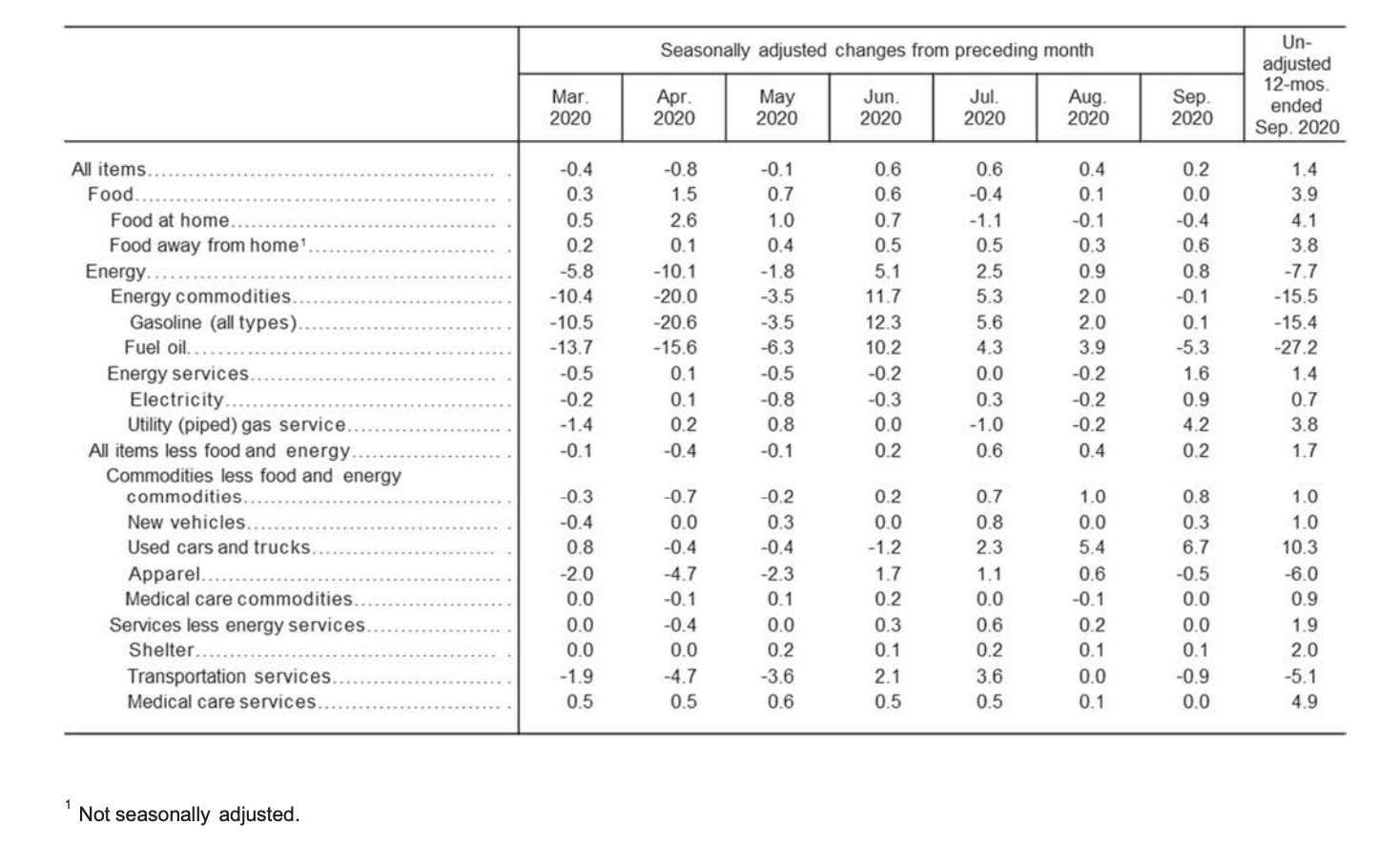
(Source: US Bureau of Labor Statistics)
All Items Less Food And Energy Index
In September, the all items less food and energy index rose 0.2%. Akin to in August, this was primarily due to the used cars and trucks index, which increased 6.7%. “The used cars and trucks index accounted for more than 100% of the monthly increase in the index for all items less food and energy,” stated the bureau in its report. Several of the component indexes all saw slight percentage increases for the month including the shelter index by 0.1%, and both the rent index and index for owners’ equivalent rent by 0.1%.
Over the last year, the all items less food and energy index increased by 1.7%. The index for shelter edged up 2%, as did the medical care index by 4.2%. Component indexes that saw percentage decreases were motor vehicle insurance, airline fares, and apparel stated the bureau.
Source cited: https://www.bls.gov/news.release/archives/cpi_10132020.htm
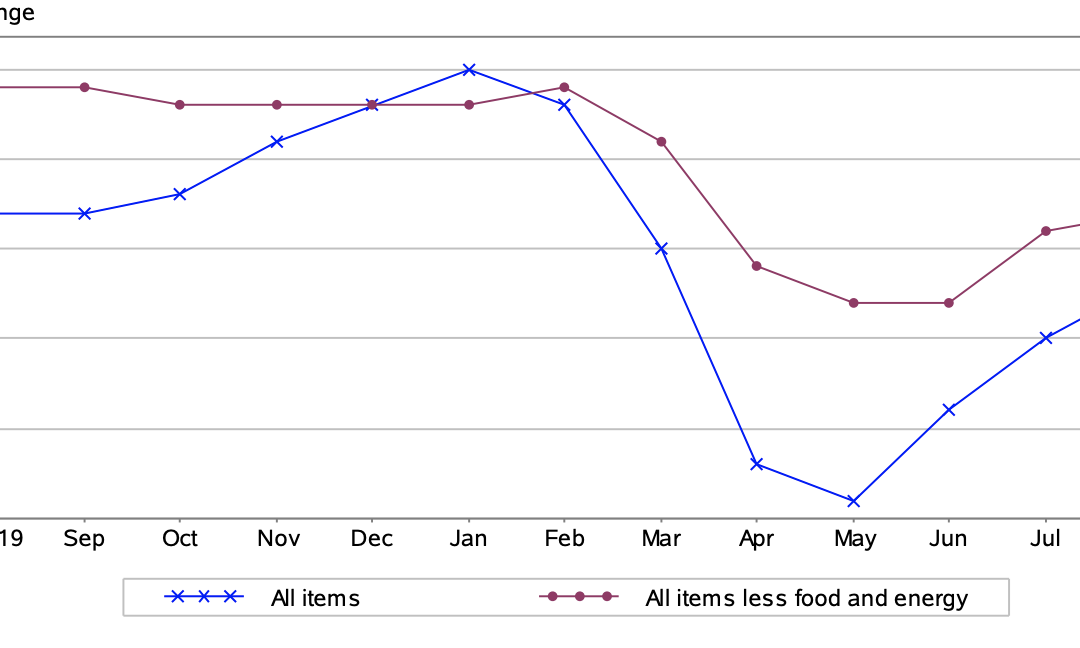
by Sarah Bauder | Sep 11, 2020 | CPI
The Consumer Price Index for All Urban Consumers (CPI-U) edged up 0.4% on a seasonally adjusted basis, reported the US Bureau of Labor Statistics. This is a slight decrease from the 0.6% rise seen in July.
Before seasonal adjustment, the all items index increased by 1.3%, over the past 12 month period.
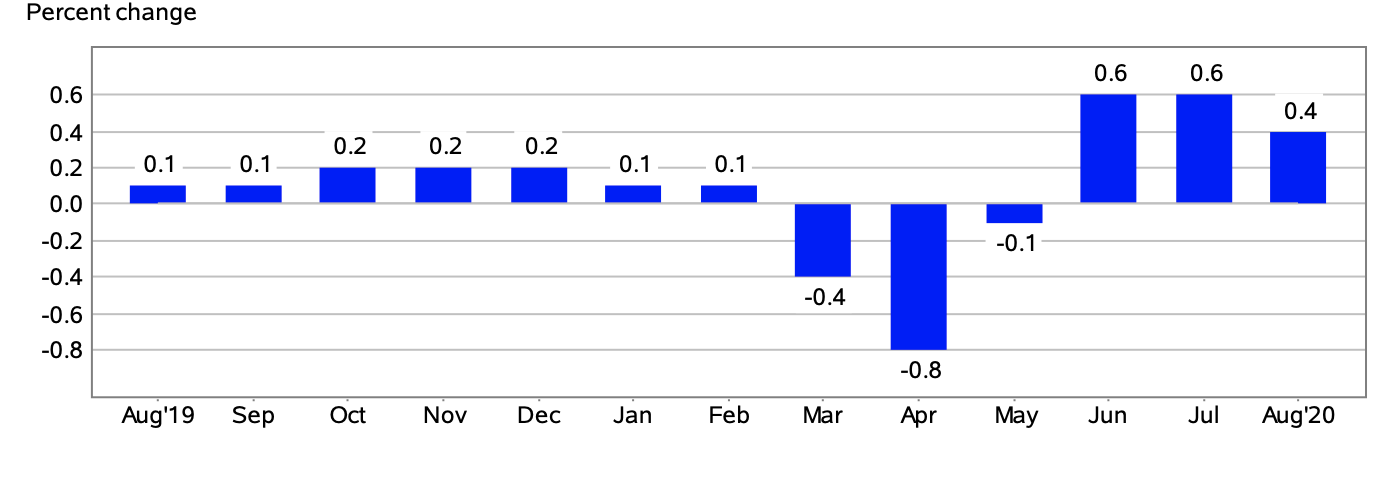
(Source: US Bureau of Labor Statistics)
Food Index
The index for food increased 0.1% in August, after seeing a 0.4% drop in July, reported the Bureau of Labor Statistics. The food at home index saw a slight decline of 0.1%. “The August decline was mostly caused by the index for meats, poultry, fish, and eggs, which fell 1.7% in August, its second consecutive monthly decline after sharp increases in prior months,” explained the bureau. Conversely, the food away from home rose 0.3% in August.
Over the last 12-months, the index for food at home edged up 4.6%. The index for meats, poultry, fish, and eggs 7.1% since this time last year. The food away from home index increased 3.5% over the past 12 months.
Energy Index
In August, the energy index increased by 0.9%, marking the third consecutive monthly percentage rise. The price of gasoline rose 2%, while both the electricity and natural gas indexes dropped 0.2%.
Over the last 12-month period, the energy index dropped 9%. The price of gas has plummeted 16.8%, as has the fuel oil index by 23.6% over the past year. In addition, the index for natural gas and electricity index both declined by 0.5% and 0.1%, respectively.
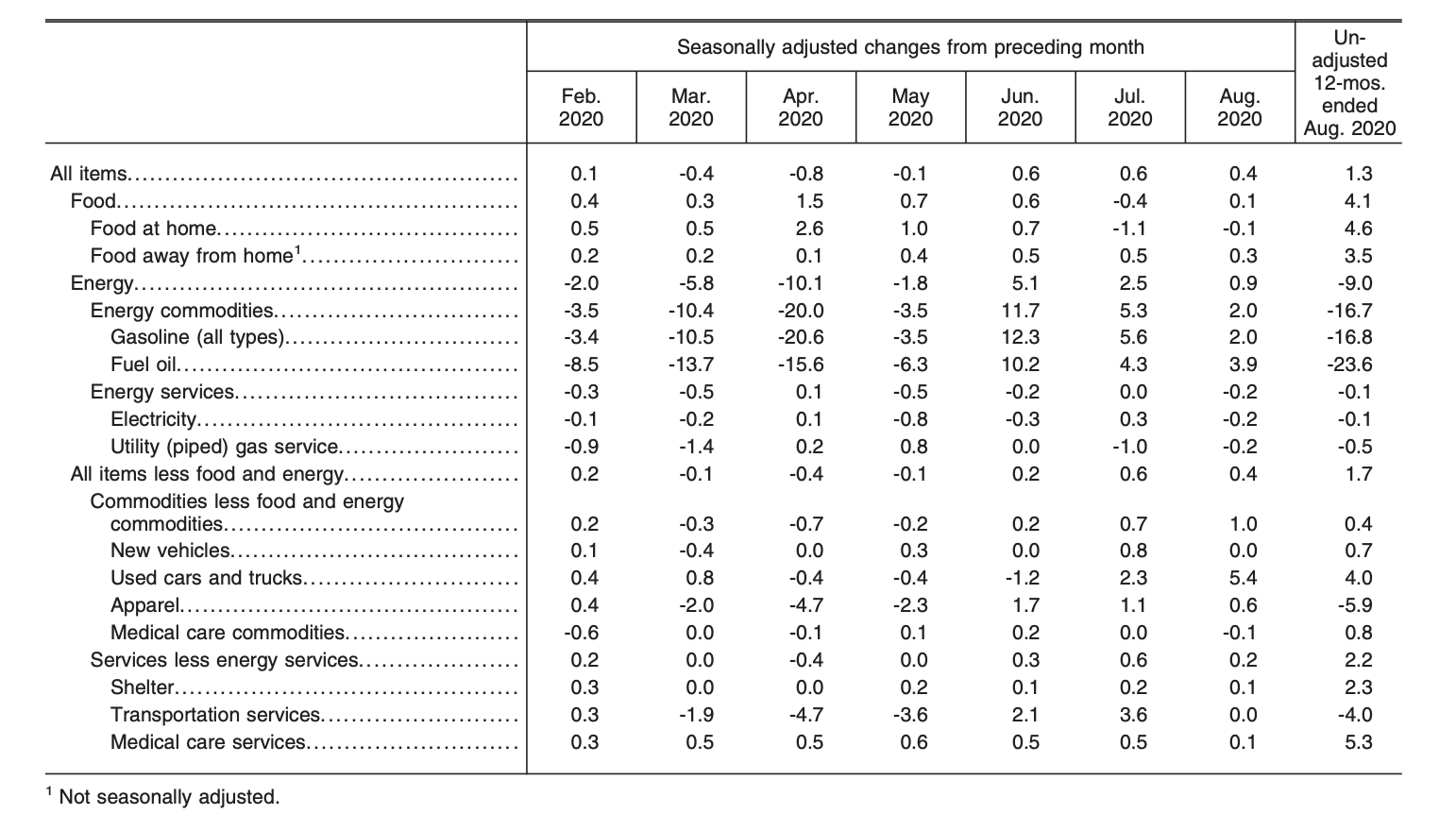
(Source: US Bureau of Labor Statistics)
All Items Less Food and Energy Index
In August, the all items less food and energy index rose 0.4%. This was primarily due to the used cars and trucks index. “The index for used cars and trucks increased 5.4% in August, its largest monthly increase since March 1969,” reported the Bureau of Labor Statistics. Several of the component indexes all saw slight percentage increases for the month including the shelter index by 0.1%, the medical care index by 0.1%, and both the rent index and index for owners’ equivalent rent by 0.1%.
Over the last year, the all items less food and energy index increased 1.7%. The index for shelter edged up 2.3%, as did the medical care index by 4.5%. Component indexes that saw major declines were airline fares (23.2%), apparel (5.9%), motor vehicle insurance (1.5%) stated the US Bureau of Labor Statistics.
Source cited: https://www.bls.gov/news.release/archives/cpi_09112020.htm

by Sarah Bauder | Aug 12, 2020 | CPI
The Consumer Price Index for All Urban Consumers (CPI-U) rose 0.6% in July on a seasonally adjusted basis, reported the US Bureau of Labor Statistics. This is the identical percentage increase seen for the month of June.
Before seasonal adjustment, the all items index has edged up 1.0%, over the past 12 month period.
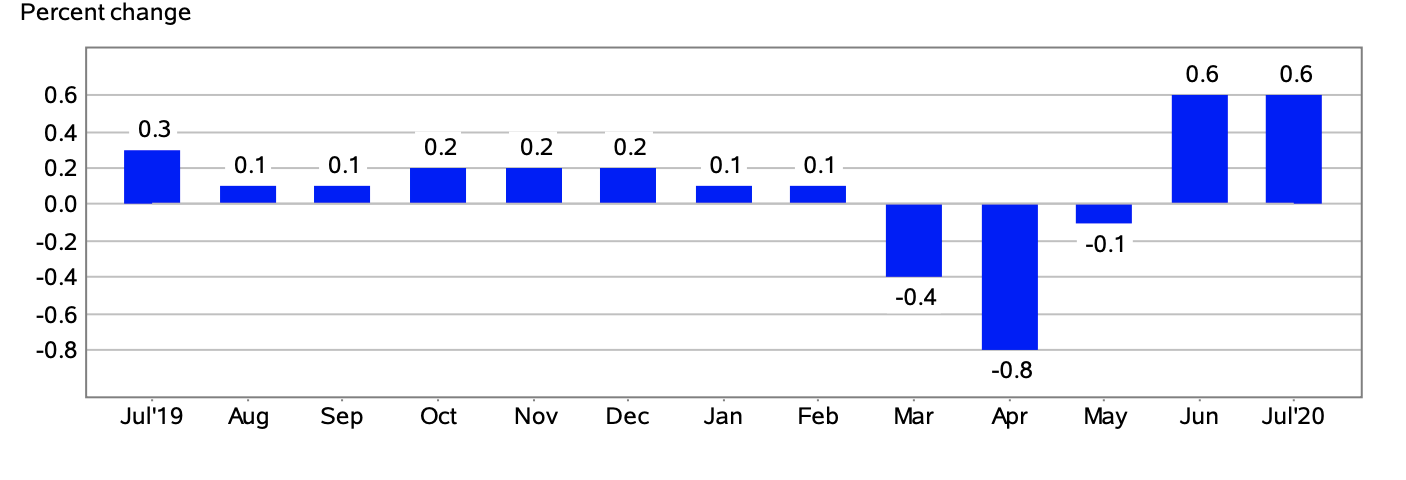
(Source: US Bureau of Labor Statistics)
Energy
In July, the index for energy increased by 2.5%, primarily because of the rise in gas prices. The gasoline index saw a 5.6% increase for the month, after a 12.3% rise in June, stated the US Bureau of Labor Statistics. The index for electricity edged up 0.3%, while conversely, the natural gas index dropped 1% for July.
Overall over the last 12-month period, energy index dropped 11.2%. Gasoline prices have plummeted 20.3%, as has the fuel oil index by 27.2% over the past year. Likewise, the natural gas index and electricity index both decreased by 0.3% and 0.1%, respectively.
Food Index
The food index dropped 0.4% in July, marking the first decrease since April 2019, reported the Bureau of Labor Statistics. The food at home index decreased 1.1%, with five of the six grocery indexes seeing percentage declines. “This decline was led by the index for beef, which fell 8.2 percent in July after increasing sharply in recent months,” stated the bureau.
Over the last 12-months, the index for food at home rose by 4.6%. The index for meats, poultry, fish, and eggs rose 8.4% since this time last year. The beef index witnessed the largest percentage increase with 14.2%.
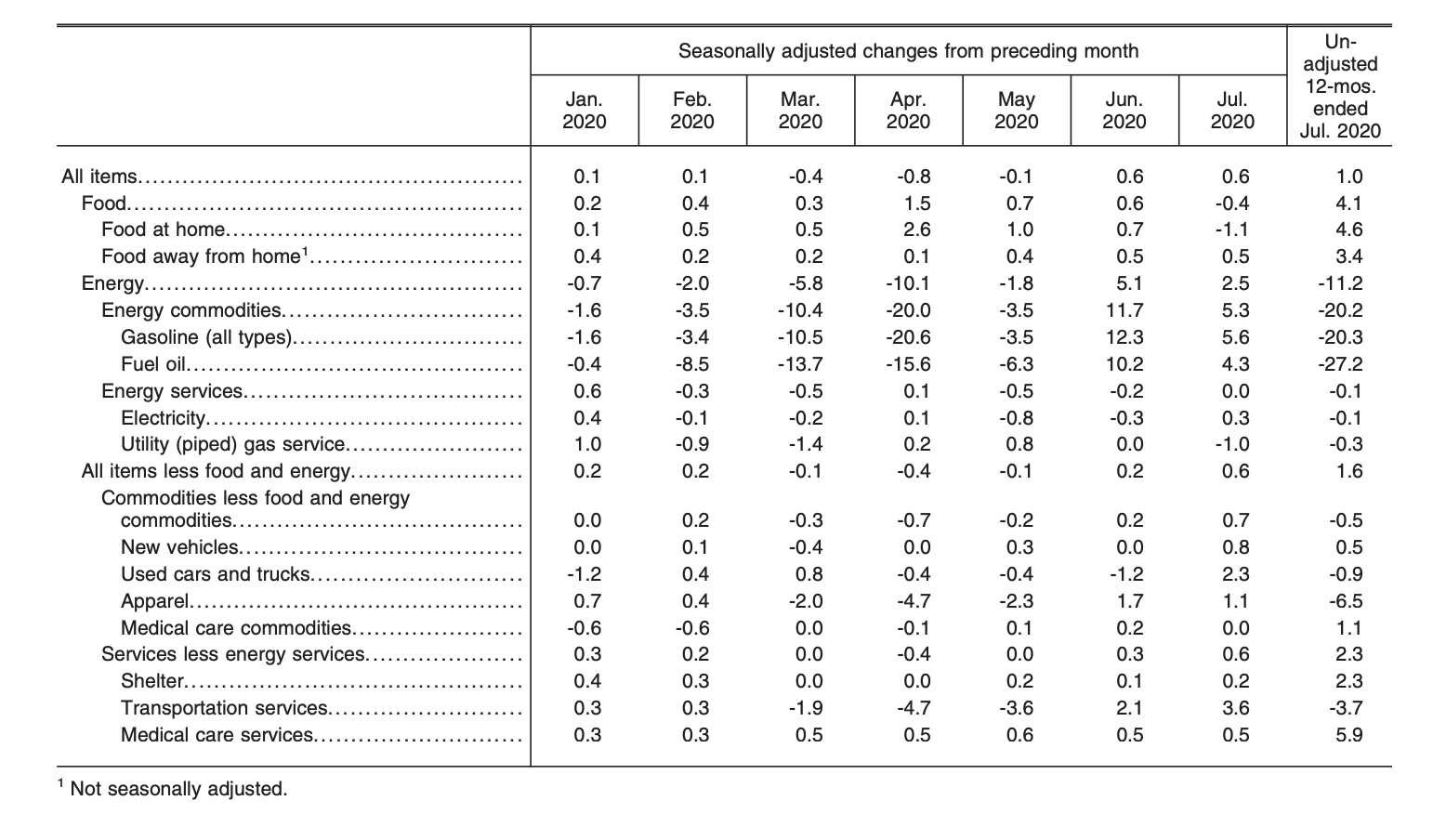
(Source: US Bureau of Labor Statistics)
All Items Less Food and Energy Index
In July, the all items less food and energy index edged up 0.6%. Component indexes all saw percentage increases for the month including motor vehicle insurance by 9.3%, the shelter index by 0.2%, and the rent index by 0.2%. In addition, the index for medical care increased by 0.4%, as did the indexes for physician services and hospital services, by 0.7% and 0.2%, respectively.
Over the past year, the all items less food and energy index increased 1.6%. The index for shelter edged up 2.3%, as did the rent index by 3.1% and the medical care index by 5%. Component indexes that saw major decreases were airline fares, apparel, motor vehicle insurance, and used cars and trucks, reported the US Bureau of Labor Statistics.
Source cited: https://www.bls.gov/news.release/archives/cpi_08122020.htm

















